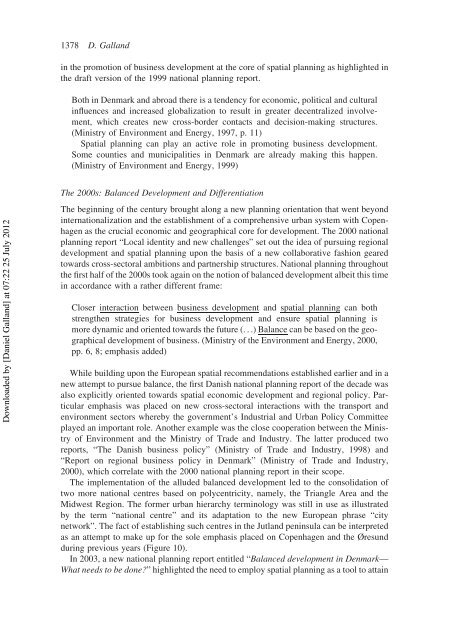Galland EPS 2012 - VBN
Galland EPS 2012 - VBN
Galland EPS 2012 - VBN
You also want an ePaper? Increase the reach of your titles
YUMPU automatically turns print PDFs into web optimized ePapers that Google loves.
1378 D. <strong>Galland</strong><br />
in the promotion of business development at the core of spatial planning as highlighted in<br />
the draft version of the 1999 national planning report.<br />
Both in Denmark and abroad there is a tendency for economic, political and cultural<br />
influences and increased globalization to result in greater decentralized involvement,<br />
which creates new cross-border contacts and decision-making structures.<br />
(Ministry of Environment and Energy, 1997, p. 11)<br />
Spatial planning can play an active role in promoting business development.<br />
Some counties and municipalities in Denmark are already making this happen.<br />
(Ministry of Environment and Energy, 1999)<br />
Downloaded by [Daniel <strong>Galland</strong>] at 07:22 25 July <strong>2012</strong><br />
The 2000s: Balanced Development and Differentiation<br />
The beginning of the century brought along a new planning orientation that went beyond<br />
internationalization and the establishment of a comprehensive urban system with Copenhagen<br />
as the crucial economic and geographical core for development. The 2000 national<br />
planning report “Local identity and new challenges” set out the idea of pursuing regional<br />
development and spatial planning upon the basis of a new collaborative fashion geared<br />
towards cross-sectoral ambitions and partnership structures. National planning throughout<br />
the first half of the 2000s took again on the notion of balanced development albeit this time<br />
in accordance with a rather different frame:<br />
Closer interaction between business development and spatial planning can both<br />
strengthen strategies for business development and ensure spatial planning is<br />
more dynamic and oriented towards the future (...) Balance can be based on the geographical<br />
development of business. (Ministry of the Environment and Energy, 2000,<br />
pp. 6, 8; emphasis added)<br />
While building upon the European spatial recommendations established earlier and in a<br />
new attempt to pursue balance, the first Danish national planning report of the decade was<br />
also explicitly oriented towards spatial economic development and regional policy. Particular<br />
emphasis was placed on new cross-sectoral interactions with the transport and<br />
environment sectors whereby the government’s Industrial and Urban Policy Committee<br />
played an important role. Another example was the close cooperation between the Ministry<br />
of Environment and the Ministry of Trade and Industry. The latter produced two<br />
reports, “The Danish business policy” (Ministry of Trade and Industry, 1998) and<br />
“Report on regional business policy in Denmark” (Ministry of Trade and Industry,<br />
2000), which correlate with the 2000 national planning report in their scope.<br />
The implementation of the alluded balanced development led to the consolidation of<br />
two more national centres based on polycentricity, namely, the Triangle Area and the<br />
Midwest Region. The former urban hierarchy terminology was still in use as illustrated<br />
by the term “national centre” and its adaptation to the new European phrase “city<br />
network”. The fact of establishing such centres in the Jutland peninsula can be interpreted<br />
as an attempt to make up for the sole emphasis placed on Copenhagen and the Øresund<br />
during previous years (Figure 10).<br />
In 2003, a new national planning report entitled “Balanced development in Denmark—<br />
What needs to be done?” highlighted the need to employ spatial planning as a tool to attain
















